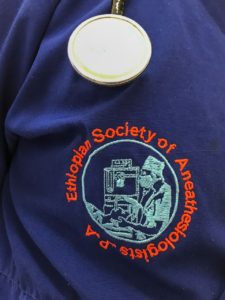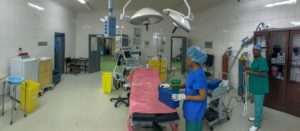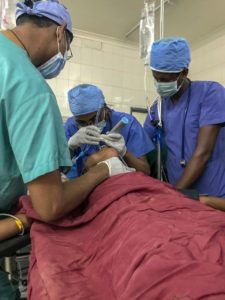Medical Jet Lag
 No matter how much international experience under your belt the initial days in a low-income country are a medical seismic shock with potential register on the Richter scale. Call it medical jet lag. A recalibration is required that necessitates a reconsideration of what you take for granted at home. My approach is to listen and simply absorb. The surgical cases are very much the same but disease processes also very different. Medical presentations are more advanced as access to definitive treatment are more limited.
No matter how much international experience under your belt the initial days in a low-income country are a medical seismic shock with potential register on the Richter scale. Call it medical jet lag. A recalibration is required that necessitates a reconsideration of what you take for granted at home. My approach is to listen and simply absorb. The surgical cases are very much the same but disease processes also very different. Medical presentations are more advanced as access to definitive treatment are more limited.
A well-trodden medical maxim states that when you hear hoof beats think horses rather than zebras. It is used to illustrate the point that uncommon presentations of common diseases occur with greater frequency than rare conditions. In Abyssinia the zebras are the horses.
Anesthesiologists were in the bathroom or asleep at the wheel when job titles were being handed out. Most people can’t pronounce it, no one can agree on how to spell it and even other physicians don’t really understand what we do. We are the witches and warlocks of the medical world. “Life guard” would be more appropriate but instead that moniker was coopted by teenage babysitters in speedos. All the credit to them and the marketing firm that locked down the term. It stands to reason. The anesthesiologist’s role is to suspend consciousness, maintaining normal physiology and guard life while the barbaric acts are performed, which under any other circumstance would constitute torture. Needless to say that the invention of anesthesia is one of the greatest human achievements of all time, right up there with the domestication of fire and the printing press. I say we go toe to toe with the pool kids and let the chips fall where they may.
 There is a ying and yang between surgeons and anesthesia colleagues; an interdependence that takes place through the mutual care of our patients. One requires the other and alone they serve no functional purpose. We are partners in an elaborate dance where the patient sets the tune, surgeon decides the steps, and the gas passer sets the dance floor. In high-income countries the symbiotic surgeon-anesthesia relationship has an equal power dynamic and modern medicine has finally recognized that the patient is the one ultimately in charge. In Canada, surgeons and anesthesiologists require five-year training programs alike for a sum total of 13 years of post-secondary education. We stand on equal footing in the operating theatre and frequently collaborate on choosing the best approach for a surgical journey for the patient.
There is a ying and yang between surgeons and anesthesia colleagues; an interdependence that takes place through the mutual care of our patients. One requires the other and alone they serve no functional purpose. We are partners in an elaborate dance where the patient sets the tune, surgeon decides the steps, and the gas passer sets the dance floor. In high-income countries the symbiotic surgeon-anesthesia relationship has an equal power dynamic and modern medicine has finally recognized that the patient is the one ultimately in charge. In Canada, surgeons and anesthesiologists require five-year training programs alike for a sum total of 13 years of post-secondary education. We stand on equal footing in the operating theatre and frequently collaborate on choosing the best approach for a surgical journey for the patient.
 The shortage of anesthesiologists and surgical load in low-income countries has resulted in a shift to use non-physician anesthesia providers with less training to fill the gap. Today the mainstay anesthesia providers in Ethiopia are anesthetists. They provide very good care and are technically quite skilled within their scope of practice. Some surgeons may prefer the anesthetists as they may be more willing to take direction without protest. Pesky anesthesiologists have a tendency to voice concerns and suggest elective surgical procedures be coordinated with the overall health of the patient to ensure optimal conditions and a reduction in postoperative complications. We often insist pain management strategies such as an epidural, which can be perceived to consume precious operating time and threaten case cancellations, all in the best interest of the patient.
The shortage of anesthesiologists and surgical load in low-income countries has resulted in a shift to use non-physician anesthesia providers with less training to fill the gap. Today the mainstay anesthesia providers in Ethiopia are anesthetists. They provide very good care and are technically quite skilled within their scope of practice. Some surgeons may prefer the anesthetists as they may be more willing to take direction without protest. Pesky anesthesiologists have a tendency to voice concerns and suggest elective surgical procedures be coordinated with the overall health of the patient to ensure optimal conditions and a reduction in postoperative complications. We often insist pain management strategies such as an epidural, which can be perceived to consume precious operating time and threaten case cancellations, all in the best interest of the patient.
Part of our role is to encourage collaborative decision making in concert with our surgical colleagues while demonstrating techniques and providing advice on anesthetic plans to ensure a safe surgical course. The first few days require acclimatization to the patients, their conditions, the surgeries and the flow of the hospital. Once you know where to find the bathroom with running water and remember to bring your toilet paper you can focus on clinical care.
Jason McVicar, February 25 2019

